

Comparing Open Source CMSs: WordPress, Joomla, Drupal and Plone. Carolina Digital Humanities Initiative. DH ToolkitsScalarA free, open source authoring and publishing platform that’s designed to make it easy for authors to write long-form, born-digital scholarship online.
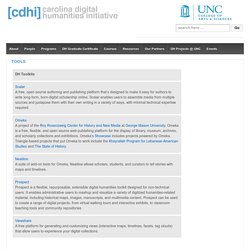
Scalar enables users to assemble media from multiple sources and juxtapose them with their own writing in a variety of ways, with minimal technical expertise required.OmekaA project of the Roy Rosenzweig Center for History and New Media at George Mason University, Omeka is a free, flexible, and open source web-publishing platform for the display of library, museum, archives, and scholarly collections and exhibitions. Omeka’s Showcase includes projects powered by Omeka. 1 Pings/Trackbacks for "Tools" Sites Using Omeka – Codex – Omeka. This list is generated by Omeka users.
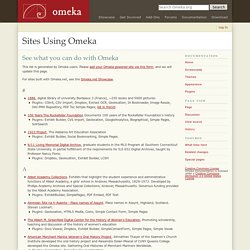
Please add your Omeka-powered site via this form, and we will update this page. For sites built with Omeka.net, see the Omeka.net Showcase. 1886, digital library of university Bordeaux 3 (France), ~250 books and 5000 pictures: Plugins: COinS, CSV Import, Dropbox, Extract OCR, Geolocation, IA Bookreader, Image Resize, OAI-PMH Repository, PDF Toc Simple Pages; list in french 100 Years:The Rockefeller Foundation Documents 100 years of the Rockefeller Foundation's history Plugins: Exhibit Builder, CVS import, Geolocation, GoogleAnalytics, Biographical, Simple Pages, SolrSearch 1923 Project, The Alabama Art Education Association Plugins: Exhibit Builder, Social Bookmarking, Simple Pages. 9/11 Living Memorial Digital Archive, graduate students in the MLS Program at Southern Connecticut State University, in partial fulfillment of the requirements for ILS 652 Digital Archives, taught by Professor Nancy Florio.
Abbot Academy Collections. Babord-Num. 5 Open Source Tools to Create Digital Exhibitions. What are digital exhibitions?
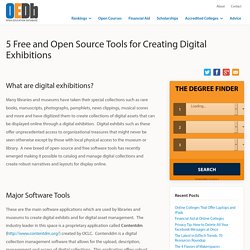
Many libraries and museums have taken their special collections such as rare books, manuscripts, photographs, pamphlets, news clippings, musical scores and more and have digitized them to create collections of digital assets that can be displayed online through a digital exhibition. Digital exhibits such as these offer unprecedented access to organizational treasures that might never be seen otherwise except by those with local physical access to the museum or library.
A new breed of open-source and free software tools has recently emerged making it possible to catalog and manage digital collections and create robust narratives and layouts for display online. Major Software Tools These are the main software applications which are used by libraries and museums to create digital exhibits and for digital asset management. Building Omeka Exhibits with Fedora Repository Content. Our NEH-funded Neatline project has inspired the Scholars’ Lab to develop or enhance several new Omeka plugins recently.
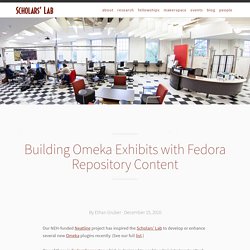
(See our full list.) One of these is FedoraConnector, which is designed to enable administrators to attach Fedora datastreams (a digital object — whether image, XML like TEI or EAD, or video) to Omeka items. This is fundamentally different from attaching files to an item–the datastream is not duplicated and stored within Omeka’s archive. Rather, a reference to the Fedora object (PID) is stored within a new table in the Omeka database that associates the item with the URL of the datastream that is accessed (and rendered) with Fedora’s REST API. The plugin also supports importing Dublin Core and MODS metadata into the DC Element Set in Omeka. TEI document from Fedora Earlier this year, we released a beta version of a plugin for rendering TEI files into HTML within Omeka. But what about indexing the document? Solr search of TEI file in Omeka.
Omeka and Its Peers. As an open source, not-for-profit, warm-and-fuzzy, community service oriented project, we don’t normally like to talk about market rivals or competitive products when we talk about Omeka.

Nevertheless, we are often asked to compare Omeka with other products. "Who’s Omeka’s competition? " is a fairly frequent question. Like many FAQs, there is an easy answer and a more complicated one. The easy answer is there is no competition. The James Merrill Digital Archive and Documenting Ferguson: Leveraging Omeka for Two Distinct Collections. This Member Update was provided by Shannon Davis, Digital Projects Librarian, Washington University in St.
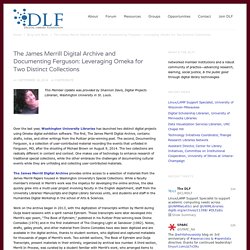
Louis. Over the last year, Washington University Libraries has launched two distinct digital projects using Omeka digital exhibition software. Which open source software is best for making a digital library? - ResearchGate. Open technologies for durable digital content. Over the years, (institutional) repositories and content management systems (CMS) have seen a great amount of feature overlap.
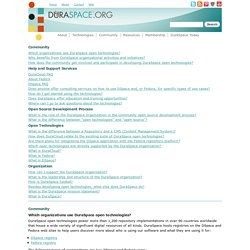
However, both systems remain distinct in their underlying purposes and the needs they fulfill. Although this is a generalization, repositories and content management systems tend to differ in the following ways: Content Management Systems (CMS) Generally speaking, a CMS may be thought of as a digital content creation & publication systemGeared towards content creation / production and online publicationGeared towards collaborative creation/modification of contentGeared towards general usage (used for any general digital content)May also be geared towards building websites and creating content for the web (Institutional) Repositories There are scenarios where one may wish to choose either a CMS or a Repository: Some general benefits of a Content Management System: Some general benefits of a Repository: Some examples of using a Repository with a CMS: Content Management vs. Content Repositories vs. Content Platforms.
Summary.
